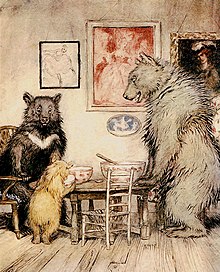Goldilocks and the Three Bears
| "Goldilocks and The Three Bears" | |
|---|---|
| Short story by Robert Southey | |
 Illustration by Arthur Rackham, 1918, in English Fairy Tales by Flora Annie Steel | |
| Original title | "The Story of the Three Bears" |
| Country | England |
| Genre(s) | Fairy tale |
| Publication | |
| Published in | The Doctor |
| Publication type | Essay and story collection |
| Publisher | Longman, Rees, etc. |
| Media type | |
| Publication date | 1837 |
"Goldilocks and the Three Bears" is a 19th-century English fairy tale of which three versions exist. The original version of the tale tells of an impudent old woman who enters the forest home of three anthropomorphic bachelor bears while they are away. She eats some of their porridge, sits down on one of their chairs, breaks it, and sleeps in one of their beds. When the bears return and discover her, she wakes up, jumps out of the window, and is never seen again. The second version replaces the old woman with a young, naive, blond-haired girl named Goldilocks, and the third and by far best-known version replaces the bachelor trio with a family of three. The story has elicited various interpretations and has been adapted to film, opera, and other media. "Goldilocks and the Three Bears" is one of the most popular fairy tales in the English language.[1]

Literary elements[edit]
The story makes extensive use of the literary rule of three, featuring three chairs, three bowls of porridge, three beds, and the three title characters who live in the house. There are also three sequences of the bears discovering in turn that someone has been eating from their porridge, sitting in their chairs, and finally, lying in their beds, at which point is the climax of Goldilocks being discovered. This follows three earlier sequences of Goldilocks trying the bowls of porridge, chairs, and beds successively, each time finding the third "just right". Author Christopher Booker characterises this as the "dialectical three" where "the first is wrong in one way, the second in another or opposite way, and only the third, in the middle, is just right". Booker continues: "This idea that the way forward lies in finding an exact middle path between opposites is of extraordinary importance in storytelling".[2]
This concept has spread across many other disciplines, particularly developmental psychology, biology, economics, and engineering where it is called the "Goldilocks principle".[3][4] In planetary astronomy, a planet orbiting its sun at just the right distance for liquid water to exist on its surface, neither too hot nor too cold, is referred to as being in the "Goldilocks Zone". As Stephen Hawking put it, "Like Goldilocks, the development of intelligent life requires that planetary temperatures be "just right'".[5]
See also[edit]
References[edit]
Citations[edit]
- ^ Elms 1977, p. 257
- ^ Booker 2005, pp. 229–32
- ^ Martin, S J (August 2011). "Oncogene-induced autophagy and the Goldilocks principle". Autophagy. 7 (8): 922–3. doi:10.4161/auto.7.8.15821. hdl:2262/73233. PMID 21552010.
- ^ Boulding, K.E. (1981). Evolutionary Economics. Sage Publications. p. 200. ISBN 9780803916487.
- ^ S Hawking, The Grand Design (London 2011) p. 194
General sources[edit]
- The Seven Basic Plots. Booker, Christopher (2005). "The Rule of Three". The Seven Basic Plots: Why We Tell Stories. Continuum International Publishing Group. ISBN 0-8264-5209-4.
- Briggs, Katherine Mary (2002) [1977]. British Folk Tales and Legends. Routledge. ISBN 0-415-28602-6.
- "Coronet: Goldilocks and the Three Bears". Internet Archive. Retrieved 21 February 2009.
- Curry, Charles Madison (1921). Children's Literature. Rand McNally & Company. p. 179. ISBN 9781344646789.
three bears.
- "Disney: Goldilocks and the Three Bears". The Encyclopedia of Disney Animated Shorts. Archived from the original on 22 February 2013. Retrieved 21 February 2009.
- Dorson, Richard Mercer (2001) [1968]. The British Folklorists. Taylor & Francis. ISBN 0-415-20426-7.
- Elms, Alan C. (July–September 1977). ""The Three Bears": Four Interpretations". The Journal of American Folklore. 90 (357): 257–273. doi:10.2307/539519. JSTOR 539519.
- "MGM: Goldilocks and the Three Bears". Archived from the original on 17 January 2013. Retrieved 12 November 2010.
- Ober, Warren U. (1981). The Story of the Three Bears. Scholars Facsimiles & Reprints. ISBN 0-8201-1362-X.
- Opie, Iona; Opie, Peter (1992) [1974]. The Classic Fairy Tales. Oxford University Press. ISBN 0-19-211559-6.
- "Roald Dahl's Goldilocks (1997)". Retrieved 3 January 2009.
- Schultz, William Todd (2005). Handbook of Psychobiography. Oxford University Press. ISBN 0-19-516827-5.
- Seal, Graham (2001). Encyclopedia of Folk Heroes. ABC-CLIO. ISBN 1-57607-216-9.
- Tatar, Maria (2002). The Annotated Classic Fairy Tales. W.W. Norton & Company. ISBN 0-393-05163-3.
External links[edit]
- "The Story of the Three Bears", manuscript by Eleanor Mure, 1831 - first recorded version
- "The Story of the Three Bears" by Robert Southey, 1837 – first published version
- "The Story of the Three Bears", versified by George Nicol, 2nd edition, 1839 (text)
- "The Three Bears" by Robert Southey – later version with "Silver-hair", a "little girl"
- "Goldilocks and the Three Bears", by Katharine Pyle, 1918 – later version with father, mother and baby bear
- Goldilocks and the Three Bears
- 1830s children's books
- 1837 short stories
- 19th-century British children's literature
- Animal tales
- Anthropomorphic bears
- Bears in literature
- British fairy tales
- English fairy tales
- English folklore
- Female characters in fairy tales
- Fictional trios
- Literary characters introduced in 1837
- Short stories adapted into films
- Short stories adapted into plays
- Works by Robert Southey

